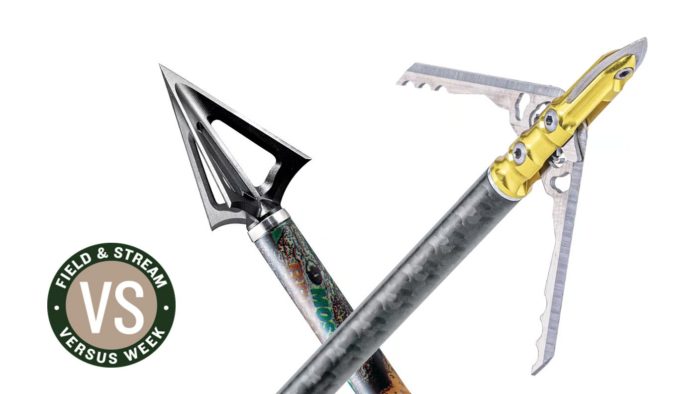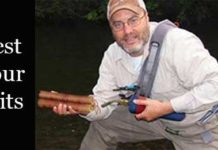Editor’s note: As hunters and anglers, we don’t agree on everything. We’ve even been known to argue on occasion. That’s why this week is all about figuring out who’s right and who’s just plain wrong. Every day we’ll be posting stories to declare a winner on hunting and fishing’s most important debates—like 870 vs. 500, summer sausage vs. venison jerky, and fly fishing vs. spin fishing. Welcome to Versus Week.
For a few particularly contentious issues, we’ve asked some our most opinionated writers to go head-to-head. To kick things off, F&S hunting editor Will Brantley and executive editor Dave Hurteau trade swipes over fixed-blade vs. mechanical broadheads in an argument that almost leaves a blood trail.
The Case for Fixed-Blade Broadheads
Lots of gut shooters prefer mechanical broadheads. That they’re gut shooters is not completely their fault, since bowhunters have long been indoctrinated with a ridiculous fear of “hitting the shoulder” and losing a deer due to inadequate arrow penetration. In my early years of bowhunting (and even in my Hunter Education classes), I was told to aim “right behind the shoulder crease,” punctuated with a stern warning that everything forward of that crease, where the front leg muscles meet the ribs, was shielded by a massive shoulder blade that will stop an arrow cold.
If that version of ungulate anatomy were true, deer would walk with a mighty stiff gait. What is true is that after following the blood trails of hundreds of big-game animals shot with a bow or crossbow (including many with a tracking dog), and skinning and quartering nearly that many of them, I can tell you unequivocally that if you’re aiming behind the crease on broadside deer, you’re purposely holding off from the deadliest place to shoot them.
Which brings us to mechanical broadheads. From the center of the rib cage back to the ham—liver to guts—yeah, a 2-inch-wide-cutting diameter gives you better odds of hitting something important. But in a contest of bad shots with either broadhead style, you’re still in for a long wait for that animal to expire, and nobody wants that.
On the flip side, a deer that’s hit in the heart and frontal lungs will almost certainly be dead within 20 seconds and 100 yards. That’s the spot to hit, and to hit it, you need to know how a deer is actually put together. The heart and major pulmonary vessels of the lungs sit directly in line with the front leg on a broadside deer, a couple of inches above the elbow joint. Some hunters think that spot is shielded by heavy bone, but it’s not. At the front of a deer’s chest, jointed leg bones actually make the point of a sideway “v” or “less-than” symbol, like this: <. The scapula, or shoulder blade, covers the spinal column on the top of that <, and the leg then extends down from the bottom point of the <. You should shoot for the middle, as if trying to zip an arrow between the jaws of a mouth-agape crocodile. Some call that spot the “vital V,” and it’s a softball-sized target on a whitetail that’s blocked by nothing except muscle. Hit it with the piss-poorest broadhead made—fixed or mechanical—and your deer is dead.
The fixed-blade’s advantage comes in two ways: If your shot is a little high on a broadside deer, it’ll have no problem punching through the scapula and breaking the spine. You’ll have to shoot the deer twice, but it’ll fall in its tracks. If your shot is too far forward and truly hits the shoulder bones, sorry, neither broadhead works for that, because you’ve missed the vitals.

Brantley’s current favorite fixed-blade head is the Wasp Havalon 125-grain HV.
The fixed-blade’s biggest advantage is for quartering-to shots. They’re much-maligned, but that doesn’t mean they’re not lethal done correctly. Ideally, the arrow slips through the crease between the leg bone and neck, where it’s an easy path to the heart. But if a fixed-blade hits the leg bone at that angle, it usually breaks it and penetrates more than enough to quickly kill anyway. That’s not something to chance on an elk or moose, but I’ve done it dozens of times on whitetails and antelope, with a 60-pound, 28-inch bow and fixed-blade broadhead. I have 100 percent more confidence in that shot than in a gut shot.
Most people know fixed-blades are sturdier, but as added proof I’ve been testing broadheads against cattle ribs—and destroying thousands of dollars’ worth of both fixed and mechanical models—the past few years. That fixed-blades hold up against and penetrate through heavy bone better than mechanicals isn’t even a debate. Mechanicals sometimes do have accuracy advantages (particularly at excessive crossbow speeds), but even that is not an absolute.
Bad shots happen to everyone, certainly including me. But do you really want to choose your broadhead because it’s the best one for gut-shooting? There are some great mechanical broadheads made, and I’ve hunted successfully with a bunch of them. But given the choice, fixed-blades win. —Will Brantley
The Case for Mechanical Broadheads
I think Brantley just called you a gut-shooter. But don’t feel too badly. It’s not your fault, he says. It’s just that you don’t know the anatomy of a deer. Which doesn’t make you stupid—just ignorant.
Well, I’m the must be the stupid one. Because I do know the anatomy of a deer. I know that there’s a soft spot ahead of the crease, between the elbow and the scapula, “or shoulder blade,” as Brantley points out for us dumb-asses. As a matter of fact—and this will come as a big surprise to my fellow gut-shooters—I aim right pretty darn tight to that front shoulder. And yet I still prefer a mechanical broadhead.

Now, I’m not going to win any 3D archery championships, but I’m a decent shot in the field, and I’m proud that I haven’t lost many deer bowhunting. But if I’m being honest with you, I’ve got to admit that I miss my exact aiming spot on deer more often than I hit it. And I’m pretty sure that’s true for all bowhunters. It’s not a knock. If your buddy aims at a buck’s crease and misses 4 inches back, you’ll be looking at a stone-dead deer and saying, “Great shot, buddy.” It’s just a fact that we aren’t perfect.
Knowing this, do you you really want to shoot at a softball-size vital area where if you’re a tad high, you hit the spine or the scapula (also known as the “shoulder blade”), and if you’re little too far forward, you’ll hit nothing but bone and muscle. A fixed-blade might punch through the scapula to hit the spine, but do you want to hit the spine?
My argument for mechanicals more or less boils down to this: I think that the basketball-size vital area behind the crease is a lot easier to hit in the moment of truth than the softball-size one in front of it. Plus, the basketball-size area has the benefit on not being tightly surrounded by heavy bones that need to be punched through or broken, so you can shoot a mechanical there without any worries about durability or penetration. Over the years, I’ve hit quite a few deer behind the crease with both fixed and mechanical heads. They both work, but from what I’ve seen, if you hit them here with a wide-cutting mechanical, the deer dies faster and leaves a better blood trail.

Hurteau currently shoots a Swhacker 100-grain 2-blade head with a 2-inch-wide cutting diameter.
There’s a little more to it than that, though, at least for me. When I hit my mark perfectly, my arrow enters tight to the shoulder. But when I miss my mark, I always miss a little back. And I mean always. In almost 25 years of bowhunting, I have never—not once—hit a deer too far forward. So, while it’s true that fixed heads are more durable, that doesn’t matter for me because I’m not going hit forward of the crease; I’m going to hit back of it—and for that I want a wide-cutting mechanical.
I think most bowhunters tend to miss a little back because we are afraid of hitting that shoulder—and that’s just fine when you consider all the deadly space behind the shoulder. You can aim at the crease and miss 4, 6, 8, even 10 inches back, and if you’re shooting a wide-cutting mechanical, that deer is dead as a hammer, and it ain’t going far either. This probably goes a long way toward explaining why in a 2019 study at Maryland’s Naval Support Facility Indian Head, which involved more than a 1,500 deer shot by archers between the years of 1989 and 2018, hunters using fixed-blade heads had a recovery rate of 82.3 percent, while those using mechanicals topped them handily at 90.7 percent.
Of course, Brantley is just busting our chops calling us gut-shooters. But I’ll just to point out that even if you do miss 10 inches back—a big miss—you’re still not into the guts. And while he mentions the area ahead of the crease and the area from the center of the rib cage back, he skips right over all that space in between—otherwise known as the vital area, and a great place to hit a deer with a big-cutting mechanical.
So, while we’re busting chops, I ask you: Who doesn’t know the anatomy of a deer?
Credit: Source link






























